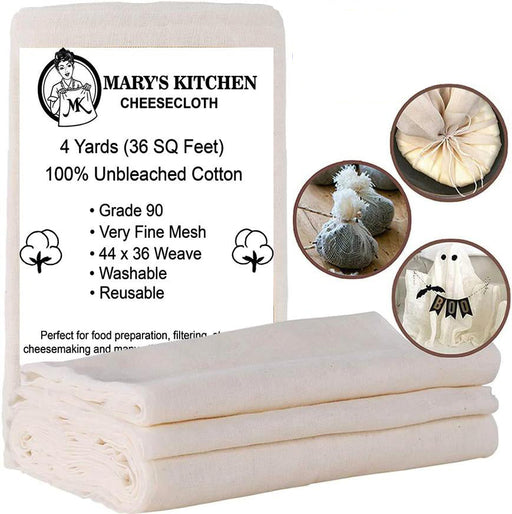Continental U.S. only.
Continental U.S. only.

Made with lint-free 100% unbleached cotton Grade 90 finest weave offers maximum strength and durability - 4 yards Very fine mash. 44 x 36 stitches...
View full details
If you’re looking for a high-quality product that is versatile and has many uses around the home, then cheesecloth is perfect for you. Our cheesecloth is highly customizable, you are free to cut them down to the size you find most easily manageable for the tasks you need cheesecloth for. Shop our unbleached, high-quality cheesecloth today.
Wondering how to pick and preserve the ideal cheese cloth for your kitchen craft? From straining homemade stocks to bundling spices, the right cheese cloth can make all the difference. This guide provides an in-depth look at how to choose and take care of cheese cloth, ensuring you’re equipped for culinary success.
Having a good understanding of the different grades of cheesecloth can greatly impact your decision. There are various options available, ranging from 10 to 100 thread counts, each offering a specific level of density for culinary and crafting purposes. The grade is an indication of the durability and thickness of the cloth. A higher grade indicates that it is stronger and more durable, making it ideal for tasks that require resilience.
For instance, Grade 90 cheesecloth is considered to be the most long-lasting option. It has superior quality, which makes it capable of enduring multiple washings and reusability without wearing out easily. This not only reduces waste, but also leads to cost savings.
Lower Grades
Cheesecloth of lower grade is characterized by an open weave and a reduced thread count, which can impact its straining and filtering abilities. This results in decreased durability and washability compared to higher grade options. This should not be seen as a disadvantage because it actually has advantages in certain situations.
The lower number of threads per inch found in low-grade cheesecloths makes them particularly suitable for tasks such as straining broths, nut milks, or berry purees. They are great for basting poultry or dusting surfaces due to their more porous structure.
Higher Grades
In contrast, there are also higher quality grades of cheesecloth available. The strength and longevity of these grades, such as Grade 90, is heavily impacted by the density of their weave.
With a higher thread count and heavier weight, they prove to be highly resilient in various kitchen applications.
Unlike open-weave cloths that need to be folded multiple times for fine filtration purposes, Grade 90 cheesecloth:
Does not require additional layers.
Its tighter weave allows it to effectively filter out finer particles that may escape lower grade options.
This makes it more efficient and convenient for tasks involving this type of filtering technique.
Cleaning with Baking Soda and Delicate Detergent
One effective way to clean cheesecloth is by using a combination of baking soda and delicate detergent. Baking soda not only refreshes the fabric, but also eliminates any unpleasant smells and helps loosen stubborn cheese proteins that may be stuck on the cloth during cleaning.
To avoid damaging the delicate fibers of the cheesecloth, it’s important to choose a gentle detergent without bleach or fabric softeners. Selecting a mild wash cycle will help prevent any potential damage to the cloth while still effectively cleansing it.
Drying Techniques
Properly drying and storing your cheesecloth is essential for maintaining its cleanliness. Once washed, it should be hung up until completely dry. If possible, hang the cloth up in sunlight, however, if that option isn’t available, a low heat cycle in the dryer may be used.
Reusing Cheesecloth
One of the main benefits of using cheesecloth is its reusability. By taking proper care, you can significantly prolong the lifespan of your cloth and reuse it multiple times.
Cheesecloth is a highly versatile and necessary tool for any kitchen. Its unique characteristics make it perfect for various tasks, such as cheese making or straining liquids. Understanding the different grades of cheesecloth, properly caring for it, and being aware of alternative options can prolong its lifespan and improve your cooking experiences greatly.
Contact us today to order our high-quality cheesecloth.
Is all cheesecloth food safe?
Yes, cheesecloth is food safe. Being free from dyes and odors, it won't alter the color or smell of your food. As it doesn't contain any harmful chemicals, it won't compromise the taste or quality of your meals. Furthermore, with unbleached natural cheesecloth for cooking, basting, straining, polishing and more, you won't have to worry about food safety or harming our environment.
What grade of cheesecloth is best for cooking?
The best grade of cheesecloth for cooking depends on the task at hand. For finer straining or tasks requiring a more durable cloth, a higher grade like Grade 90 is recommended. However, for coarser filtration or tasks that do not require a high level of durability, lower grades are suitable.
What should I look for in a cheesecloth?
When choosing a cheesecloth, consider its grade based on your specific needs. If you plan to use it for fine straining or repeated use, a higher grade like Grade 90 is ideal. Additionally, consider whether the cheesecloth is bleached or unbleached.
Should I cook with bleached or unbleached cheesecloth?
It is recommended to cook with unbleached cheesecloth. Unbleached cheesecloth does not contain any harsh bleaching chemical residues that are typically used in the bleaching process of fabrics.
